Exploring, Improving, Evolving Self Identity
Contents
- 1 Introduction
- 2 Enhancing Self-Awareness
- 3 Setting Meaningful Goals
- 4 Managing Stress and Emotions
- 5 Cultivating Positive Relationships
- 6 Nurturing a Growth Mindset
- 7 Cultivating Gratitude and Positive Thinking
- 8 Building Self-Confidence and Self-Esteem
- 9 Promoting Mindfulness and Well-being
- 10 Conclusion: Embracing Personal Growth and Self-Help
- 11 References
Introduction
Self-help is a concept that has gained significant popularity in recent years, as individuals strive for personal growth and self-improvement. It encompasses various techniques and practices aimed at enhancing one’s well-being, developing skills, and achieving personal goals.
Self-help can be defined as a proactive approach to personal development, where individuals take responsibility for their own growth and actively seek out strategies to improve their lives
In this article we will explore multiple areas of self help including self awareness, setting meaningful goals, managing stress & emotions, growth mindset, gratitude & positive thinking, self confidence & self esteem and last but not least mindfulness.

Understanding Self-Help: Benefits and Limitations
Self-help offers numerous benefits to individuals who engage in it.
- It empowers people to take control of their lives, fostering a sense of agency and autonomy.
- By actively working on oneself, individuals can develop a deeper understanding of their strengths and weaknesses, enabling them to make informed decisions and take purposeful actions.
- Self-help also promotes self-awareness, which is crucial for personal growth and achieving a greater sense of fulfillment.
Jump to:
However, it is important to acknowledge the limitations of self-help.
- While self-help resources can provide valuable insights and guidance, they are not a substitute for professional help when dealing with serious mental health issues.
- It is essential to recognize the boundaries of self-help and seek appropriate support when necessary.
- Additionally, self-help techniques may not yield immediate results and require consistent effort and commitment to bring about meaningful change.
The Role of Self-Help in Personal Growth and Well-being
Self-help plays a vital role in personal growth and well-being by providing individuals with the tools and resources to navigate life’s challenges effectively. It encourages a proactive mindset and empowers individuals to take charge of their own development. By incorporating self-help practices into their lives, individuals can cultivate resilience, enhance emotional intelligence, and foster a positive mindset.
Self-help also promotes self-care, emphasizing the importance of prioritizing one’s physical and mental well-being. It encourages individuals to engage in activities that promote relaxation, stress reduction, and self-reflection. By taking time for self-care, individuals can recharge, rejuvenate, and maintain a healthy work-life balance.
Enhancing Self-Awareness
Self-awareness is the ability to focus on yourself and how your actions, thoughts, or emotions do or don’t align with your internal standards. Self-awareness is how an individual experiences and understands their own character, feelings, motives, and desires.[1]
Self-awareness allows individuals to gain insights into their behaviors, motivations, and patterns of thinking, enabling them to make conscious choices aligned with their goals and values.
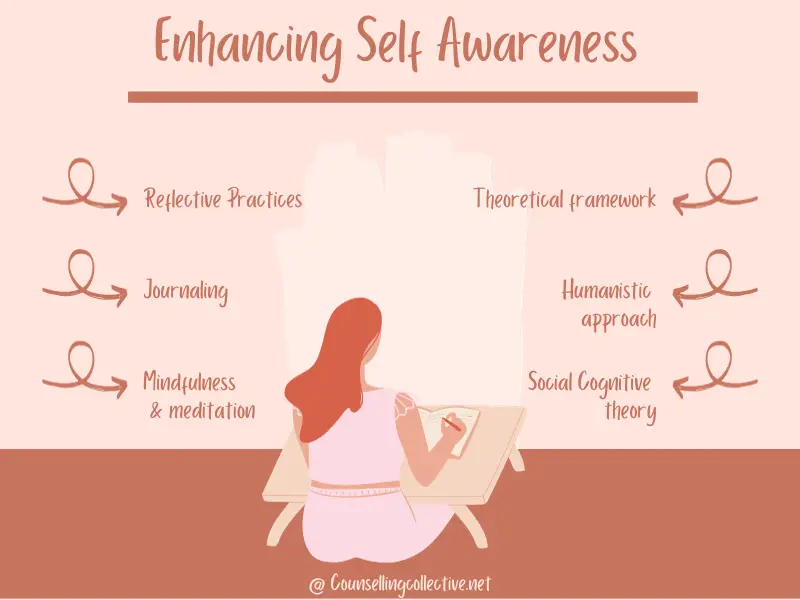
Reflective Practices for Self-Exploration and Insight
Self-awareness can be enhanced by the self exploration. Self exploration includes being inquisitive about one’s own beliefs, emotions and desires and how they affect the surrounding.
Individuals can attain insights about self through process of exploration, experiment and feedback. If you allow your feelings to settle into your body, you can form a hypothesis of why that feeling was emerged and what was its stimulus. Then the experiment involves trying out different possibilities of that hypothesis and incorporating feedback from environment and repeating this process.
Through this process one can attain insights about self which are valuable for self improvement and change.
Following practices can be used for self-exploration:
- Journaling and Self reflection
- Mindfulness and meditation
Journaling and Self-Reflection
Journaling is a powerful self-help tool that promotes self-reflection and enhances self-awareness. By regularly writing in a journal, individuals can explore their thoughts, emotions, and experiences in a structured manner. It provides an opportunity to gain clarity, process emotions, and identify patterns or recurring themes in one’s life. Journaling can be done in various forms, such as gratitude journaling, goal journaling, or free-flowing writing, depending on personal preference. [2]
Mindfulness and Meditation
Mindfulness and meditation practices are effective methods for cultivating self-awareness. Mindfulness involves intentionally paying attention to the present moment without judgment. By practicing mindfulness, individuals can develop a non-reactive and non-judgmental awareness of their thoughts, emotions, and bodily sensations.
Meditation, on the other hand, involves training the mind to focus and redirect thoughts. Regular meditation practice can improve concentration, reduce stress, and enhance self-awareness. [3]
Psychological Theories to enhance Self-Awareness
Carl Rogers’ Humanistic Theory
Carl Rogers’ humanistic theory emphasizes the importance of self-actualization and self-awareness in personal growth. According to Rogers, individuals have an innate drive to develop their full potential and strive for self-actualization.
Self-awareness plays a central role in this process, as it allows individuals to align their thoughts, feelings, and actions with their authentic selves, leading to greater fulfillment and well-being.
Roger’s theory states the stages of self actualization which a person can use to enhance the self-awareness. [4]
Albert Bandura’s Social Cognitive Theory
Albert Bandura’s social cognitive theory is a turning stone in social psychology which highlights the role of self-reflection and self-observation in personal development. Bandura suggests that individuals learn and develop by observing others and themselves. By engaging in self-reflection and self-observation, individuals can gain insights into their behaviors and beliefs, identify areas for improvement, and make positive changes.
Bandura also emphasizes the importance of self-efficacy, the belief in one’s ability to succeed, in achieving personal goals. [5]
Setting Meaningful Goals
One of the important aspects of self-help is to set meaningful goals. We have all experienced such circumstances where we are unable to achieve the goals that we set for our self. Most popular example would be on new year where we have multiple resolutions for the upcoming year but after couple of months into the year, we loose track of them. Therefore, it is important to set meaningful goals.
Goal setting is a proactive process that empowers individuals to take deliberate action and make progress in their lives.

Setting meaningful goals provides direction, motivation, and a sense of purpose in life. It allows individuals to break free from routine and strive for personal growth and achievement.
Benefits of Goal Setting
Goal setting has benefits which include:
- Increased motivation: goal setting increases motivation by creating sense of purpose and achievement
- Improved focus: Having goals helps you to stay focused on what is important and to avoid getting sidetracked.
- Increased self-confidence: When you achieve your goals, you feel a sense of accomplishment and self-confidence.
- Improved well-being: Goal setting can lead to improved mental and physical well-being.
Issues Faced while Goal Setting and Achievement
Setting and achieving goals can sometimes be challenging due to various factors, including:
- Lack of Clarity: Vague or poorly defined goals can impede progress. When goals lack clarity, individuals may struggle to develop effective action plans or measure their success.
- Fear of Failure: Fear of failure can discourage individuals from setting ambitious goals or taking risks. It can lead to self-doubt, procrastination, or a reluctance to step outside one’s comfort zone.
- Unrealistic goals: If your goals are too unrealistic, you are more likely to give up on them.
- Procrastination: Putting off your goals can make them seem more daunting and less achievable.
- Fear of failure: The fear of failure can prevent you from taking action and pursuing your goals. [6]
Strategies for Effective Goal Setting
SMART Goal Framework
The SMART goal framework is a widely used approach for effective goal setting. SMART stands for Specific, Measurable, Assignable, Relevant, and Time-bound. Specific goals clearly define what needs to be accomplished, while measurable goals provide a way to track progress.
Goals should be achievable, taking into account one’s capabilities and resources. Relevant goals align with one’s values, interests, and aspirations. Lastly, goals should be time-bound, with a clear deadline for completion. [7]
Breaking Down Goals into Actionable Steps
Breaking down goals into actionable steps is an essential strategy for effective goal attainment. By dividing larger goals into smaller, manageable tasks, you can create a roadmap for success. Each step acts as a building block, bringing individuals closer to their ultimate objective. Breaking down goals also helps to maintain momentum and provides a sense of accomplishment as each task is completed.
Theories in goal setting
Edwin Locke’s Goal-Setting Theory
Edwin Locke’s goal-setting theory suggests that specific and challenging goals lead to higher levels of motivation and performance. According to this theory, setting clear and specific goals provides individuals with a roadmap and a sense of direction. Challenging goals stimulate individuals to exert greater effort, resulting in improved performance and achievement. [6]
Mihaly Csikszentmihalyi’s Flow Theory
Mihaly Csikszentmihalyi’s flow theory explores the optimal psychological state that individuals experience when fully engaged in an activity. Flow occurs when individuals are fully absorbed in what they are doing, feeling a sense of enjoyment and deep concentration.
Setting meaningful goals that align with one’s skills and interests can facilitate the experience of flow, leading to heightened motivation, creativity, and a sense of fulfillment. [8]
By effectively utilizing the strategies on setting goals and being mindful of the theories regarding goal setting, one can set achievable SMART goals which would help in the path towards self actualization and self-help.
Managing Stress and Emotions
Stress can be defined as a state of worry or mental tension caused by a difficult situation. Stress is a natural human response that prompts us to address challenges and threats in our lives. [9]
Recognizing the signs and symptoms of stress is the first step towards managing it. These signs may include physical manifestations such as headaches, muscle tension, or changes in appetite, as well as psychological symptoms like irritability, difficulty concentrating, or feeling overwhelmed.
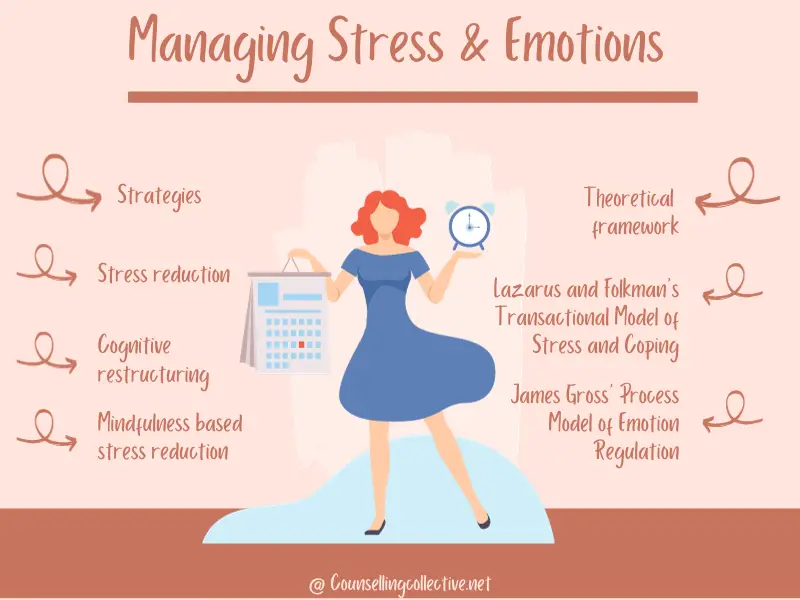
To cope with stress, self-help techniques can be employed. These may include:
- Time management: Prioritizing tasks, setting realistic deadlines, and breaking tasks into smaller, manageable steps can help reduce feelings of being overwhelmed and improve productivity.
- Stress reduction activities: Engaging in activities that promote relaxation and stress reduction can be beneficial. This may involve practicing deep breathing exercises, engaging in regular physical exercise, listening to calming music, or participating in activities such as yoga or meditation.
- Healthy lifestyle habits: Maintaining a balanced diet, getting enough sleep, and avoiding excessive caffeine or alcohol consumption can support overall well-being and help manage stress levels.
Strategies for Emotional Regulation
Emotional regulation is the process of effectively managing and responding to one’s emotions.
Why do we need emotional regulation? Emotional regulation is a coping mechanism which helps us in maintaining normal functioning during high stress environment. For example, if a person is driving and hears news of death of a close relative, then emotional regulation will be required so that he/she can continue driving without getting into an accident.
There are many ways to regulate emotions. Major ones are given below:
Stress Reduction Techniques
Stress reduction techniques can be effective in managing emotions. Engaging in activities like deep breathing exercises, progressive muscle relaxation, or engaging in hobbies or activities that bring joy and relaxation can help reduce stress levels and promote emotional well-being.
Cognitive Restructuring
Cognitive restructuring involves identifying and challenging negative or irrational thoughts and replacing them with more realistic and positive ones.
By reframing negative thoughts and focusing on more constructive perspectives, individuals can regulate their emotions and reduce the impact of negative thinking patterns. [10]
Learn more: Cognitive Psychology
Mindfulness-Based Stress Reduction
Mindfulness-based stress reduction practices, such as mindfulness meditation, can help individuals develop awareness of their emotions and cultivate a non-judgmental and accepting attitude towards them.
By practicing mindfulness, individuals can observe their emotions without getting overwhelmed by them, fostering emotional regulation and resilience.
Theories regarding coping with stress:
Lazarus and Folkman’s Transactional Model of Stress and Coping
Lazarus and Folkman’s Transactional Model of Stress and Coping emphasizes the role of cognitive appraisal in the stress response. According to this model, individuals appraise stressors by evaluating the demands of a situation and their available resources to cope with it.
This appraisal process influences the emotional and physiological responses to stress. Self-help techniques aligned with this model often involve cognitive restructuring, which aims to modify the cognitive appraisal of stressors and promote adaptive coping strategies. [11]
James Gross’ Process Model of Emotion Regulation
James Gross’ Process Model of Emotion Regulation provides insights into the processes involved in regulating emotions. This model suggests that individuals engage in two types of emotion regulation strategies:
- Antecedent-focused strategies that occur before the emotional response (such as cognitive reappraisal)
- Response-focused strategies that occur after the emotional response (such as expressive suppression). Self-help techniques can draw from this model to help individuals develop skills in cognitive reappraisal, mindfulness, and other strategies to effectively regulate their emotions. [12]
Cultivating Positive Relationships
Positive relationships are vital for emotional well-being and personal growth. Nurturing healthy and supportive relationships involves fostering mutual respect, open communication, and emotional support.
Here are some key aspects of cultivating positive relationships:
- Effective communication and active listening
- Showing empathy & understanding
- Respecting differences and diversity
- Forgiveness and letting go of resentment
- Building boundaries and maintaining healthy relationship dynamics

Effective Communication and Active Listening
Effective communication forms the foundation of healthy relationships. It involves expressing oneself clearly, actively listening to others, and seeking to understand their perspectives.
Active listening requires giving full attention, acknowledging the speaker’s feelings, and responding empathetically. Self-help resources can provide guidance on effective communication techniques, such as using “I” statements, practicing empathy, and nonverbal communication skills.
Showing Empathy and Understanding
Empathy is the ability to understand and share the feelings of another person. [13]
Cultivating empathy is crucial for building and maintaining positive relationships. It involves putting oneself in the other person’s shoes, validating their emotions, and responding with compassion.
Self-help practices can help individuals develop empathy by practicing active empathy, perspective-taking, and compassionate listening.
Respecting Differences and Diversity
Respecting differences and embracing diversity is essential for fostering positive relationships. This encourages individuals to recognize and appreciate the unique perspectives, values, and backgrounds of others.
It includes being open-minded, practicing tolerance, and avoiding judgments based on cultural, religious, or personal differences.
Forgiveness and Letting Go of Resentment
Forgiveness is a powerful practice that can promote healing and strengthen relationships. It is an essential element for long-lasting relationships as conflicts occur and differences arise during the course of a relationship. Both require forgiveness for all the parties involved for betterment of relationship.
Holding onto resentment and grudges can strain relationships and hinder personal growth. Self-help encourages individuals to practice forgiveness by letting go of negative emotions, cultivating empathy, and seeking reconciliation when appropriate. This practice can contribute to healthier and more fulfilling relationships.
Building Boundaries and Maintaining Healthy Relationship Dynamics
Setting healthy boundaries is essential for maintaining positive relationships. Self-help resources guide individuals in establishing clear boundaries that respect their own needs and values while also considering the needs of others.
Healthy relationship dynamics involve mutual respect, open communication, and shared decision-making. Maintaining these dynamics contributes to the overall health and longevity of relationships.
Theories to enhance positive relationship cultivation:
John Bowlby’s Attachment Theory
John Bowlby’s Attachment Theory highlights the significance of early attachment experiences in shaping interpersonal relationships throughout life. According to this theory, the quality of early caregiver-child relationships influences an individual’s attachment style, which in turn affects their relationships in adulthood. Self-help resources can draw upon this theory to help individuals develop secure attachment styles, which involve trust, emotional availability, and healthy dependence within relationships. [14]
Gary Chapman’s Five Love Languages
Gary Chapman’s Five Love Languages theory proposes that individuals have different ways of expressing and receiving love: words of affirmation, acts of service, receiving gifts, quality time, and physical touch. Understanding and speaking one another’s love languages can enhance communication, emotional connection, and intimacy in relationships. Self-help resources often incorporate principles from this theory to help individuals identify their own and their partner’s love languages, promoting relationship satisfaction and harmony.
In conclusion, managing stress, regulating emotions, and cultivating positive relationships are essential aspects of self-help. By implementing strategies for stress management, emotional regulation, effective communication, empathy, and respect, individuals can enhance their well-being and nurture fulfilling relationships. Understanding the psychological theories that underpin self-help approaches provides a foundation for implementing evidence-based strategies and achieving personal growth and satisfaction. [15]
Nurturing a Growth Mindset
A growth mindset is the belief that one’s abilities and intelligence can be developed through dedication, effort, and learning.
Embracing a growth mindset is crucial for personal development, as it allows individuals to approach challenges with resilience and see failures as opportunities for growth.
By adopting a growth mindset, individuals open themselves up to continuous learning, improvement, and personal transformation.
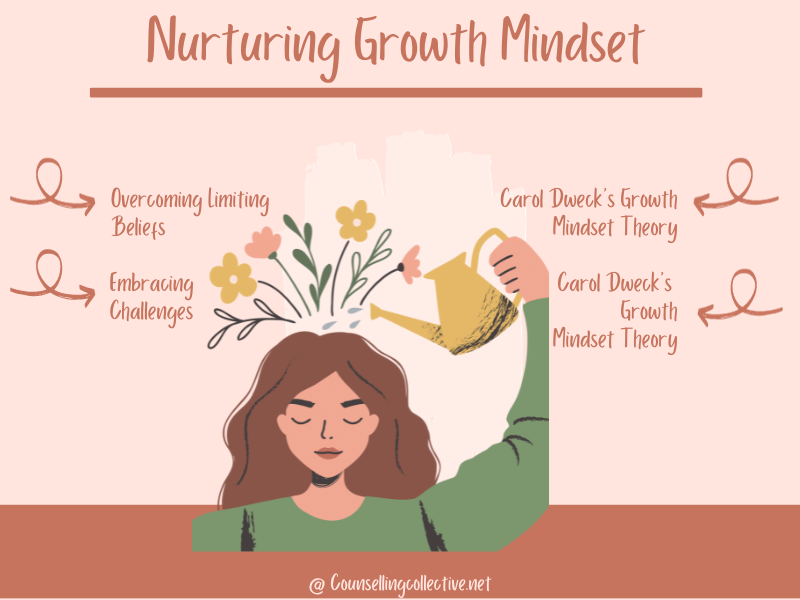
Overcoming Limiting Beliefs and Embracing Challenges
1. Embracing a Learning Orientation
Embracing a learning orientation involves shifting focus from outcomes to the process of learning and growth.
Instead of fearing failure or feeling discouraged by setbacks, individuals with a learning orientation see challenges as opportunities to develop new skills and knowledge. They approach tasks with curiosity, ask questions, and actively seek feedback to improve their performance.
2. Emphasizing Effort and Persistence
In a growth mindset, effort and persistence are valued as essential elements of success. Individuals with a growth mindset understand that mastery and achievement come through hard work, dedication, and perseverance.
They view setbacks as temporary and use them as motivation to continue striving towards their goals.
Theories to support growth mindset:
1. Carol Dweck’s Growth Mindset Theory
Carol Dweck’s growth mindset theory posits that individuals’ beliefs about intelligence and abilities impact their motivation and achievement. A growth mindset promotes the belief that abilities can be developed through effort and learning, leading to greater resilience and success. Self-help approaches drawing from this theory encourage individuals to cultivate a growth mindset by reframing challenges, embracing learning opportunities, and nurturing a belief in their own potential for growth. [16]
2. Albert Bandura’s Self-Efficacy Theory
Albert Bandura’s self-efficacy theory suggests that individuals’ beliefs in their own abilities influence their motivation, behavior, and success. Developing self-efficacy involves setting challenging goals, experiencing success, receiving constructive feedback, and observing others who demonstrate competence. Self-help practices aligned with this theory focus on building self-efficacy by setting achievable goals, acknowledging progress, and seeking role models or mentors who can inspire and guide personal development. [17]
Cultivating Gratitude and Positive Thinking
Gratitude is a powerful practice that can positively shape one’s perspective and enhance overall well-being. By consciously focusing on and appreciating the good things in life, individuals can shift their mindset towards positivity, resilience, and a greater sense of fulfillment.
Cultivating gratitude allows individuals to acknowledge and savor the positive aspects of their lives, even during challenging times.

Following table highlights key activities that an individual can include in his daily routine to adapt to attitude of gratitude:
| Keeping a Gratitude Journal | It involves regularly writing down moments, experiences, or things for which one is grateful |
| Positive Affirmations and Self-Talk | By intentionally repeating positive statements about oneself and one’s abilities, individuals can rewire their thought patterns and reinforce positive self-perceptions |
| Finding Joy in Everyday Moments | By savoring simple pleasures, practicing gratitude, and noticing the beauty around them, individuals can cultivate a positive and appreciative mindset |
Theories to enhance attitude of Gratitude & Positive thinking:
Martin Seligman’s Theory of Positive Psychology
Martin Seligman’s theory of positive psychology focuses on the study of optimal human functioning and well-being. Positive psychology explores factors that contribute to happiness, fulfillment, and flourishing.
Developing gratitude and positive thinking aligns with this theory by promoting positive emotions, engagement in life, meaningful relationships, and a sense of accomplishment and purpose. [18]
Robert Emmons’ Research on Gratitude
Robert Emmons’ research on gratitude highlights the numerous benefits of cultivating gratitude, including improved well-being, increased life satisfaction, and enhanced relationships.
Emmons’ work demonstrates that gratitude practices positively influence emotional, physical, and social aspects of life. Self-help resources draw upon this research to guide individuals in incorporating gratitude into their daily lives and reaping its wide-ranging benefits. [19]
Building Self-Confidence and Self-Esteem
Self-confidence and self-esteem are essential components of personal well-being and growth. Self-confidence refers to believing in one’s abilities and having faith in one’s capacity to handle challenges and achieve goals.
Self-esteem encompasses a broader sense of self-worth and self-acceptance. Building and nurturing self-confidence and self-esteem are vital for personal empowerment, resilience, and success.
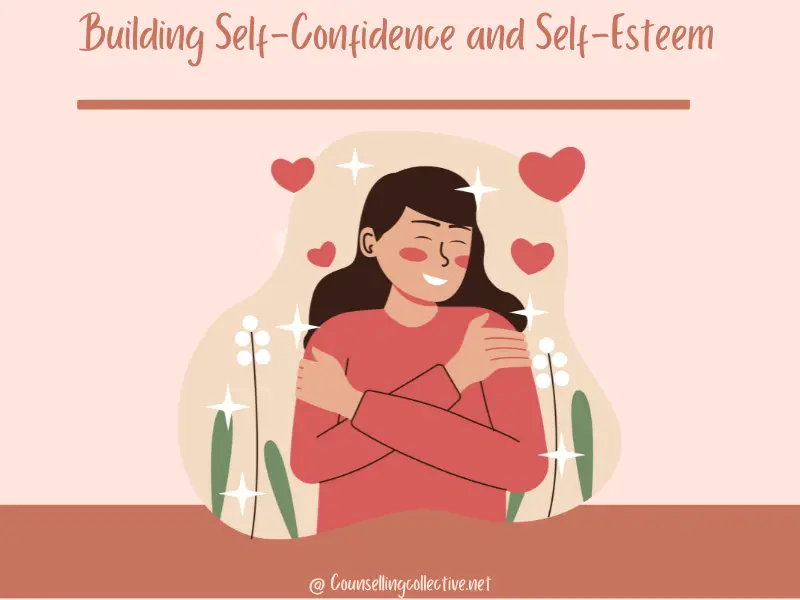
Following strategies can be utilized to boost Self-Confidence and Self-Esteem:
| Recognizing Personal Strengths and Accomplishments | By acknowledging one’s achievements, talents, and positive qualities, individuals can develop a more positive self-perception and foster a sense of pride and self-worth. |
| Setting Realistic Expectations | Setting realistic expectations involves understanding one’s limitations, acknowledging that mistakes and setbacks are part of the learning process, and avoiding self-imposed pressure to be perfect. |
| Challenging Self-Doubt | Challenging self-doubt involves questioning negative self-beliefs and reframing them with more positive and realistic thoughts. |
| Practicing Self-Compassion and Self-Acceptance | It involves treating oneself with kindness, understanding, and forgiveness. It means acknowledging one’s imperfections and embracing oneself with unconditional positive regard. |
Issues Faced while Building Self-Esteem
Developing a confident self with high self-esteem is a challenging task and idiosyncratic journey for everyone. Major hiccups on the road to high self-esteem involve following:
- Negative Self-Talk: Internalizing negative beliefs about oneself can undermine self-esteem. Negative self-talk, self-criticism, and distorted self-perceptions can create a cycle of low self-esteem and self-doubt.
- Comparison and Social Pressure: Constantly comparing oneself to others or striving for external validation can erode self-esteem. The pressure to meet societal expectations or conform to unrealistic standards can lead to feelings of inadequacy.
- Unrealistic expectations. If we have unrealistic expectations of ourselves, we are more likely to feel disappointed and frustrated.
- Low self-confidence. If we lack self-confidence, we are more likely to avoid challenges and to give up easily.
Theories to build self-confidence and self-esteem
Nathaniel Branden’s Self-Esteem Theory
Nathaniel Branden’s self-esteem theory emphasizes the importance of self-esteem in personal growth and happiness. According to Branden, self-esteem is built upon self-acceptance, self-responsibility, self-assertiveness, and living in alignment with one’s values.
Self-help resources influenced by this theory guide individuals in developing healthy self-esteem through self-reflection, self-acceptance, and the cultivation of personal authenticity. [20]
Self-Determination Theory
Developed by Edward Deci and Richard Ryan, this theory highlights the importance of autonomy, competence, and relatedness in promoting self-esteem and confidence. When individuals feel they have control over their actions and can achieve their goals, it enhances their self-esteem. [21]
Therapies to Build Self-Esteem
Fortunately, several therapeutic approaches and techniques can help individuals build and enhance their self-esteem. These approaches include:
- Cognitive-Behavioral Therapy (CBT): CBT helps individuals identify and challenge negative thought patterns and replace them with more realistic and positive self-perceptions. It focuses on changing behaviors, beliefs, and attitudes that contribute to low self-esteem.
- Positive Affirmations: Affirmations involve consciously repeating positive statements about oneself to counter negative self-talk. By practicing positive affirmations regularly, individuals can rewire their thinking patterns and reinforce self-acceptance and self-worth.
- Acceptance and commitment therapy (ACT): ACT is a type of therapy that helps people to accept their thoughts and feelings, and to focus on taking action towards their goals.
Promoting Mindfulness and Well-being
Mindfulness is the practice of intentionally paying attention to the present moment with openness, curiosity, and non-judgment.
Embracing mindfulness can enhance mental and emotional well-being by reducing stress, improving focus and concentration, and promoting overall resilience.
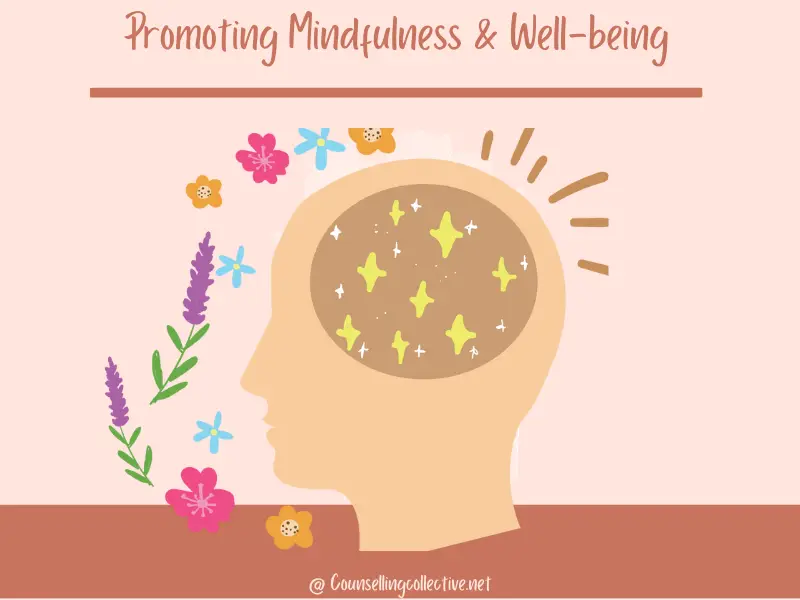
Mindfulness allows individuals to cultivate a deeper understanding of their thoughts, emotions, and bodily sensations, leading to increased self-awareness and a greater sense of inner peace.
Mindfulness and Self-Awareness
Mindfulness and self-awareness are essential components of personal development. They involve cultivating a present-moment, non-judgmental awareness of one’s thoughts, emotions, and sensations.
There are many benefits to developing mindfulness and self-awareness, including:
- Reduced stress and anxiety: When we are mindful, we are less likely to get caught up in negative thoughts and emotions. This can lead to a reduction in stress and anxiety.
- Improved focus and concentration: Mindfulness can help us to focus on the present moment and to stay on task. This can be helpful in both our personal and professional lives.
- Increased self-compassion: When we are self-aware, we are more likely to be understanding and compassionate towards ourselves. This can lead to a greater sense of self-acceptance and well-being.
- Improved relationships: Mindfulness can help us to be more present and engaged in our relationships. This can lead to stronger and more fulfilling relationships.
Issues Faced while Developing Mindfulness and Self-Awareness
While striving to develop mindfulness and self-awareness, individuals may encounter various challenges that hinder their progress. Common issues include:
- Mind Wandering: The mind’s tendency to wander can make it challenging to stay focused and fully present. Intrusive thoughts and distractions can disrupt the practice of mindfulness and hinder the development of self-awareness.
- Self-Judgment: The inner critic and self-judgment can arise during moments of self-reflection. Harsh self-criticism or an overly critical mindset can undermine self-awareness and hinder personal growth.
- Fear of judgment: Some people may be afraid of being judged for practicing mindfulness or self-awareness. This fear can prevent them from taking the time to develop these skills.
- The busyness of modern life: In today’s fast-paced world, it can be difficult to find the time to slow down and be mindful.
- Our own thoughts and emotions: Our thoughts and emotions can sometimes be a barrier to mindfulness. We may find ourselves getting caught up in negative thoughts or emotions, which can make it difficult to stay present.
Theories to support mindfulness:
Jon Kabat-Zinn’s Mindfulness-Based Stress Reduction
Jon Kabat-Zinn’s mindfulness-based stress reduction (MBSR) is a program that combines mindfulness meditation, body awareness, and yoga to promote well-being and reduce stress. MBSR incorporates mindfulness practices into daily life, teaching individuals to cultivate a non-judgmental and accepting attitude towards their experiences. Self-help resources influenced by MBSR offer guidance on incorporating mindfulness into daily routines and enhancing overall well-being.[22]
Ellen Langer’s Theory of Mindfulness
Ellen Langer’s theory of mindfulness emphasizes the importance of actively noticing new things and being fully present in the present moment. According to Langer, mindlessness, or being on autopilot, can limit personal growth and well-being. Self-help approaches drawing from this theory encourage individuals to cultivate mindfulness by actively engaging with their experiences, challenging assumptions, and embracing novelty, leading to increased vitality and well-being.[23]
Therapies or techniques that help in development of Mindfulness and Self-Awareness
Numerous therapeutic approaches and techniques can support individuals in cultivating mindfulness and developing self-awareness. These approaches include:
- Mindfulness-Based Stress Reduction (MBSR): MBSR is a program that combines mindfulness meditation, body awareness, and yoga. It helps individuals develop a heightened sense of present-moment awareness, reducing stress and enhancing self-awareness.
- Breath Awareness: Practicing focused attention on the breath can serve as a gateway to mindfulness and self-awareness. By observing the breath, individuals anchor themselves in the present moment and cultivate a deeper understanding of their internal experiences.
- Meditation: Meditation is a practice that can help us to focus our attention on the present moment. There are many different types of meditation, so you can find one that works for you.
- Yoga: Yoga is a physical practice that can also help us to develop mindfulness and self-awareness. Yoga can help us to connect with our bodies and to become more aware of our breath.
- Journaling: Journaling can be a helpful way to track our thoughts and feelings. This can help us to become more aware of our patterns and to learn from our experiences.
- Talk therapy: Talk therapy can help us to explore our thoughts, feelings, and behaviors. This can help us to develop a deeper understanding of ourselves and to make positive changes in our lives.
Conclusion: Embracing Personal Growth and Self-Help
In conclusion, self-help practices provide valuable tools and strategies for personal growth, well-being, and fulfillment. By embracing a growth mindset, cultivating gratitude and positive thinking, building self-confidence, and promoting mindfulness, individuals can embark on a journey of self-discovery and personal transformation. Psychological theories, such as Carol Dweck’s growth mindset theory, Martin Seligman’s theory of positive psychology, and Jon Kabat-Zinn’s mindfulness-based stress reduction, offer insights and evidence-based approaches to support the effectiveness of self-help practices.
Through self-help, individuals can empower themselves to overcome challenges, nurture positive relationships, manage stress and emotions, and cultivate a deeper understanding of themselves. Embracing self-help is a lifelong commitment to personal growth and continuous learning, leading to greater well-being, resilience, and a more fulfilling life.
References
[1] Self-awareness, Wikipedia
[2] Wood, J. (2013). Transformation Through Journal Writing: The Art of Self-reflection for the Helping Professions. United Kingdom: Jessica Kingsley Publishers. Amazon
[3] Kabat-Zinn, J. (2016). Wherever You Go, There You Are: Mindfulness Meditation for Everyday Life. United Kingdom: Little, Brown Book Group. Amazon
[4] Thorne, B., Sanders, P. (2012). Carl Rogers. United Kingdom: SAGE Publications. Amazon
[5] Bandura, A. (1977). Social Learning Theory. United Kingdom: Prentice Hall. Amazon
[6] Locke, E. A., & Latham, G. P. (2002). Building a successful career: A guide to setting and achieving your goals. New York, NY: Plume.
[7] The SMART Criteria: The SMART Way to Set Objectives. (2015). Belgium: 50Minutes.com. Amazon
[8] Csikszentmihalyi, M. (1990). Flow: The psychology of optimal experience. Harper & Row. Amazon
[9] Stress as defined by WHO, 2023.
[10] Cognitive Restructuring, Wikipedia 2023.
[11] Lazarus, R. S., Folkman, S. (1984). Stress, appraisal, and coping. New York: Springer Publishing Company. Amazon.
[12] Handbook of Emotion Regulation. (2011). United States: Guilford Publications. Amazon
[13] Krznaric, R. (2015). Empathy: Why It Matters, and How to Get It. United States: Penguin Publishing Group. Amazon.
[14] Bowlby J. (1982). Attachment and loss: retrospect and prospect. The American journal of orthopsychiatry, 52(4), 664–678.
[15] Chapman, G. (2015). The 5 love languages: The secret to love that lasts. Northfield Publishing. Amazon
[16] Dweck, C. S. (2007). Mindset: The New Psychology of Success. United States: Random House Publishing Group. Amazon
[17] Self-Efficacy in Changing Societies. (1997). United Kingdom: Cambridge University Press. Amazon.
[18] Seligman, M. E. P. (2011). Flourish: A Visionary New Understanding of Happiness and Well-being. India: Atria Books. Amazon.
[19] Emmons, R. A. (2007). Thanks! How the New Science of Gratitude Can Make You Happier. United Kingdom: Houghton Mifflin Company. Amazon.
[20] Branden, N. (2001). The Psychology of Self-Esteem: A Revolutionary Approach to Self-Understanding that Launched a New Era in Modern Psychology. United Kingdom: Wiley. Amazon.
[21] Ryan, R. M., Deci, E. L. (2018). Self-Determination Theory: Basic Psychological Needs in Motivation, Development, and Wellness. United Kingdom: Guilford Publications. Amazon.
[22] Lehrhaupt, L., Meibert, P. (2017). Mindfulness-Based Stress Reduction: The MBSR Program for Enhancing Health and Vitality. United States: New World Library. Amazon.
[23] Langer, E. J. (2014). Mindfulness (25th Anniversary Edition). United States: Hachette Books. Amazon.
